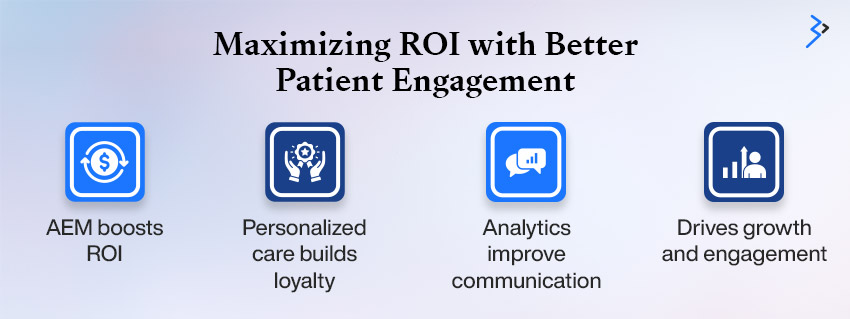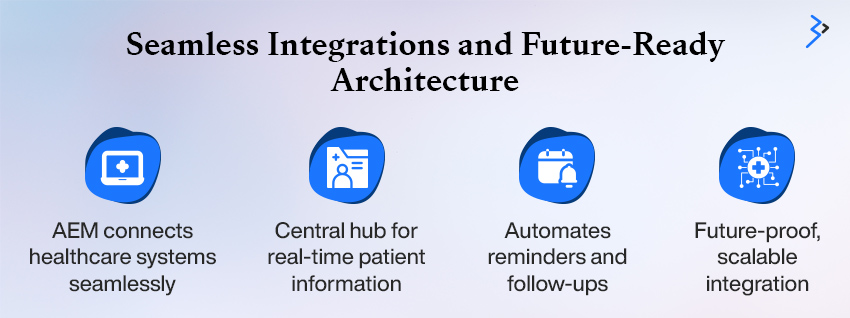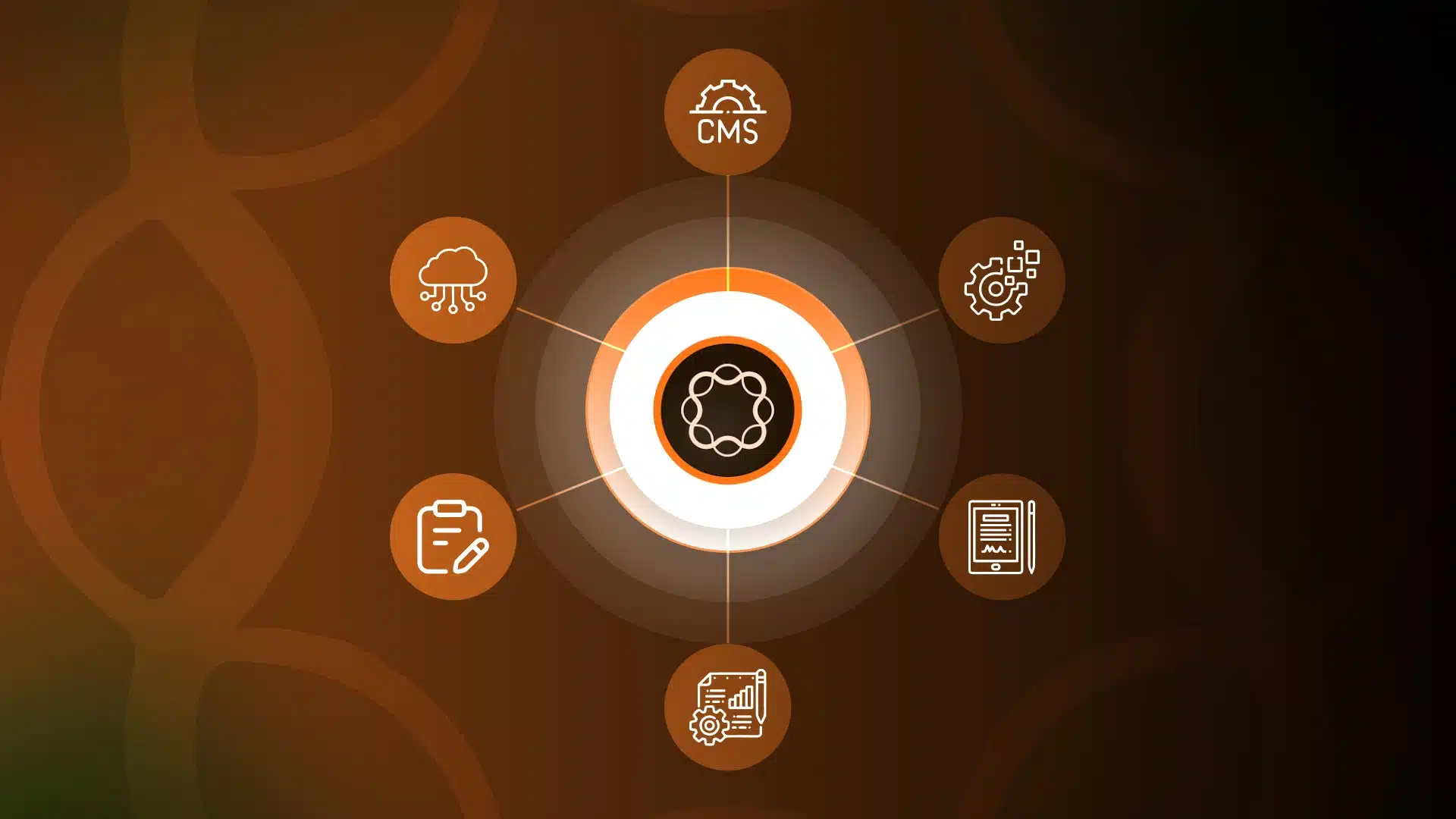Have you ever wondered how we can order groceries, book flights, or manage our finances in just a few taps today? Naturally, patients expect the same ease from healthcare providers: quick access, personalized experiences, and seamless digital touchpoints. They’re no longer just “patients”; they’re digital consumers.
But healthcare hasn’t always kept up. Fragmented systems, siloed data, and heavy admin work have frustrated patients and clinicians alike. The situation is problematic because it creates difficulties, makes people less likely to trust each other, affects the quality of care, and increases costs.
The old one-size-fits-all approach to communication no longer works in a world that values proactive, tailored interactions. That’s where a Digital Experience Platform (DXP) comes in, and Adobe Experience Manager Services (AEM) leads the way. More than a content management system, AEM helps healthcare organizations deliver personalized, connected, consistent digital experiences across every touchpoint. It acts as a single “digital front door,” replacing scattered efforts with a unified platform for today’s healthcare challenges.
1. Crafting a Seamless Patient Experience

Today, a patient’s journey doesn’t start in a waiting room; it begins online. Every touchpoint shapes how patients view their providers, from searching for symptoms to booking appointments, filling pre-visit forms, and following up with post-care resources.
Here’s the catch: if the digital experience feels confusing or frustrating, many patients will switch providers. A study by Dialog Health found that only 64% of people rated their healthcare experience as “good” or “very good,” the lowest level in recent years.
Healthcare organizations have a significant opportunity to improve their operations. With Adobe Experience Manager (AEM), providers can build a unified digital front door, easy-to-use portals, mobile-friendly scheduling, and smooth telehealth access. By delivering the correct information to the right person at the right time, AEM turns a disjointed journey into one that feels seamless, trustworthy, and patient-centered.
2. Keeping Healthcare Data Secure and Compliant
Healthcare data is some of the most sensitive information in the world, and it’s heavily regulated. A single breach can cost millions and shatter patient trust. 725 data breaches were reported in 2023 alone, exposing over 133 million patient records.
Adobe Experience Manager (AEM) integrates security as a fundamental principle in its design. It supports compliance with strict standards like HIPAA and offers enterprise-grade protections such as data encryption, detailed access controls, and real-time monitoring. By managing all content and patient-facing forms on a secure, centralized platform, healthcare providers can significantly reduce risks and keep patient information safe. Partnering with a trusted healthcare software development company further ensures robust solutions that streamline workflows and protect sensitive data.

The Power of Cloud-Native Security
In the past, hospitals and clinics had to handle every security update and patch themselves an enormous burden. AEM as a Cloud Service integrates security from the start, benefiting organizations with:
- Automatic updates that address new threats instantly
- Secure credential management
- Regular vulnerability scanning
- Granular permissions, so only the right people have access to sensitive content.
A multi-layered security approach safeguards patient data and assures healthcare organizations that compliance and trust are integral to the system.
Read More – Unlocking Operational Insights with an AI Assistant in Adobe Experience Platform
3. Empowering Clinicians and Staff with Digital Tools

Healthcare professionals face heavy workloads, and outdated systems can detract from patient care. AEM simplifies this by acting as a central hub for content and communication. Staff can manage hospital policies, share news, and access training in one place. Integrating with EHRs and back-end systems allows AEM to streamline tasks and reduce errors, allowing teams to prioritize patient care.
AEM offers a user-friendly interface for staff to publish updates, approve content, and launch campaigns without extensive training. For example, marketing can update flu shot reminders, medical admins can implement telehealth guidelines, and department heads can share memos in one platform. By automating routine tasks, AEM reduces administrative stress and lets teams concentrate on patient engagement and care innovation.
4. Driving Agile, Scalable Content Delivery
In healthcare, quick and flexible content delivery is vital. AEM Cloud Service helps organizations overcome delays caused by legacy systems, allowing them to scale instantly and operate smoothly during busy times like flu season or enrollment.
A Brillio case study showed that one primary healthcare provider cut its digital content launch time by 40% after adopting AEM, turning what once took months into just a few weeks. Even more powerful is AEM’s headless CMS approach. Instead of rewriting or reformatting content for every channel, website, app, social media marketing, or voice assistant, teams create it once and deliver it everywhere, ensuring that patients receive timely and consistent information, regardless of how they connect.
5. Maximizing ROI with Better Patient Engagement

Digital transformation in healthcare is a significant investment, and leaders naturally want measurable returns. Adobe Experience Manager (AEM) helps make that possible by turning digital tools into stronger patient connections and financial results.
Patients who feel understood and cared for are more likely to stay loyal and recommend your services. That loyalty directly impacts the bottom line. A Deloitte study showed that one health plan boosted annual revenue by $55–150 million simply by focusing on personalized digital interactions that reduced patient churn.
AEM simplifies and enhances personalization in healthcare through analytics that reveal patient behavior, leading to customized communication. This reduces patient frustrations with scheduling and billing, benefiting both patients and organizations by lowering call center traffic and accelerating revenue cycles.
AEM promotes new services and specialty clinics, boosting patient utilization and market share. Overall, AEM converts digital platforms into growth engines that improve engagement and ensure long-term success.
Read More – Scaling eCommerce Success with Adobe Experience Manager and Cloud Integration
6. Building Trust Through a Unified Brand
Keeping a consistent brand can be challenging for large hospital networks with many clinics and specialty centers. Patients may feel confused or lose trust if websites, apps, or patient portals look and feel different.
Adobe Experience Manager (AEM) solves this by giving hospitals one central platform to manage all digital content and assets. With its multi-site and digital asset management (DAM) tools, hospitals can ensure that every logo, color, message, and patient interaction follows the same brand guidelines.
This consistency creates a seamless experience, whether a patient visits the main hospital website, a specialty clinic portal, or a mobile app. When patients see the same look, tone, and professionalism at every touchpoint, they feel more confident and trust that they’re part of a well-organized, reliable healthcare system.
7. Seamless Integrations and Future-Ready Architecture

Healthcare runs on dozens of systems, from EHRs like Epic and Cerner to patient relationship management (PRM) tools. These platforms need to communicate with each other to deliver a smooth patient experience.
That’s where Adobe Experience Manager (AEM) shines. With its open architecture and powerful APIs, AEM acts like the central nervous system of digital healthcare. It pulls data from different sources, keeps everything in sync, and ensures patients and staff see the correct information at the right time.
For example, AEM can connect with an EHR to update patient portals with lab results or upcoming appointments. It can also link to PRM systems to send automated reminders or follow-up emails after visits.
By serving as this integration hub, AEM helps healthcare organizations break down data silos, automate workflows, and deliver personalized, real-time experiences across every touchpoint. Even better, this flexible setup is future-proof, ready to scale and evolve as new technologies and patient needs emerge.
Read More – Elevate your Adobe Experience Manager Sites Website with Generative AI Chatbots
Conclusion: Shaping the Future of Healthcare Through Experiences
Healthcare is more than just tests and treatments; it’s about the patient experience. Patients want to feel understood and supported, making digital transformation essential in today’s healthcare landscape. Adobe Experience Manager (AEM) enables providers to create seamless journeys where patients can book appointments, access personalized resources, and trust their data is secure.
By adopting a Digital Experience Platform like AEM, healthcare organizations can blend compassion with technology to create efficient, patient-centered experiences. At Brainvire, we focus on enhancing patient confidence and connection throughout their journey. As a trusted Adobe partner, we’re dedicated to helping you design meaningful healthcare experiences.
FAQs:-
A Digital Experience Platform (DXP) is a unified technology that helps organizations deliver engaging digital experiences. It combines content management, personalization, data analytics, and marketing tools. In healthcare, a DXP like AEM centralizes systems, improves data security, and addresses the needs of tech-savvy patients.
AEM offers enterprise-grade security and can be configured to comply with healthcare regulations like HIPAA. Its cloud-native architecture includes advanced encryption, granular access controls, and real-time monitoring, helping healthcare organizations reduce data breach risks and protect patient information.
A Headless CMS separates content from presentation, allowing content created in AEM to be dynamically delivered to any channel, like websites and apps. In healthcare, this ensures consistent information across platforms, eliminating the need for manual reformatting and republishing, and enabling organizations to reach patients anywhere.
Enhancing the digital experience for patients can yield substantial financial benefits. A Deloitte report noted that a health plan boosted its annual revenue by $150 million through personalized digital interactions, reducing patient churn and streamlining administrative tasks. Thus, the plan improved operational efficiency and maximized revenue from digital channels.
A unified digital experience creates seamless interactions. For example, a patient can find a specialist on a hospital’s website, receive personalized content, get a mobile notification with pre-visit forms after booking an appointment, and then a follow-up email with information about their condition, all utilizing integrated EHR data.
Related Articles
-
How Custom Adobe Commerce Builds Trust in Jewelry Ecommerce
Digital commerce has reshaped how customers discover, evaluate, and purchase products. Easy access to information, transparent comparisons, and seamless transactions are no longer differentiators; they are baseline expectations. As luxury
-
Streamline Content Operations: Adobe Workfront Meets AEM Guides
Imagine a situation where your design teams, technical documents, and programming department are all being well aligned without any more cluttered tools, lost deadlines, and the dreaded series of emails.
-
The Future of Unified Retail Commerce – Blending Online & In-Store with Adobe Experience Cloud
The retailing world is evolving. Gone are the days of a simple brick-and-mortar store or an e-commerce site. Customers of today do not view channels or see a brand. They




